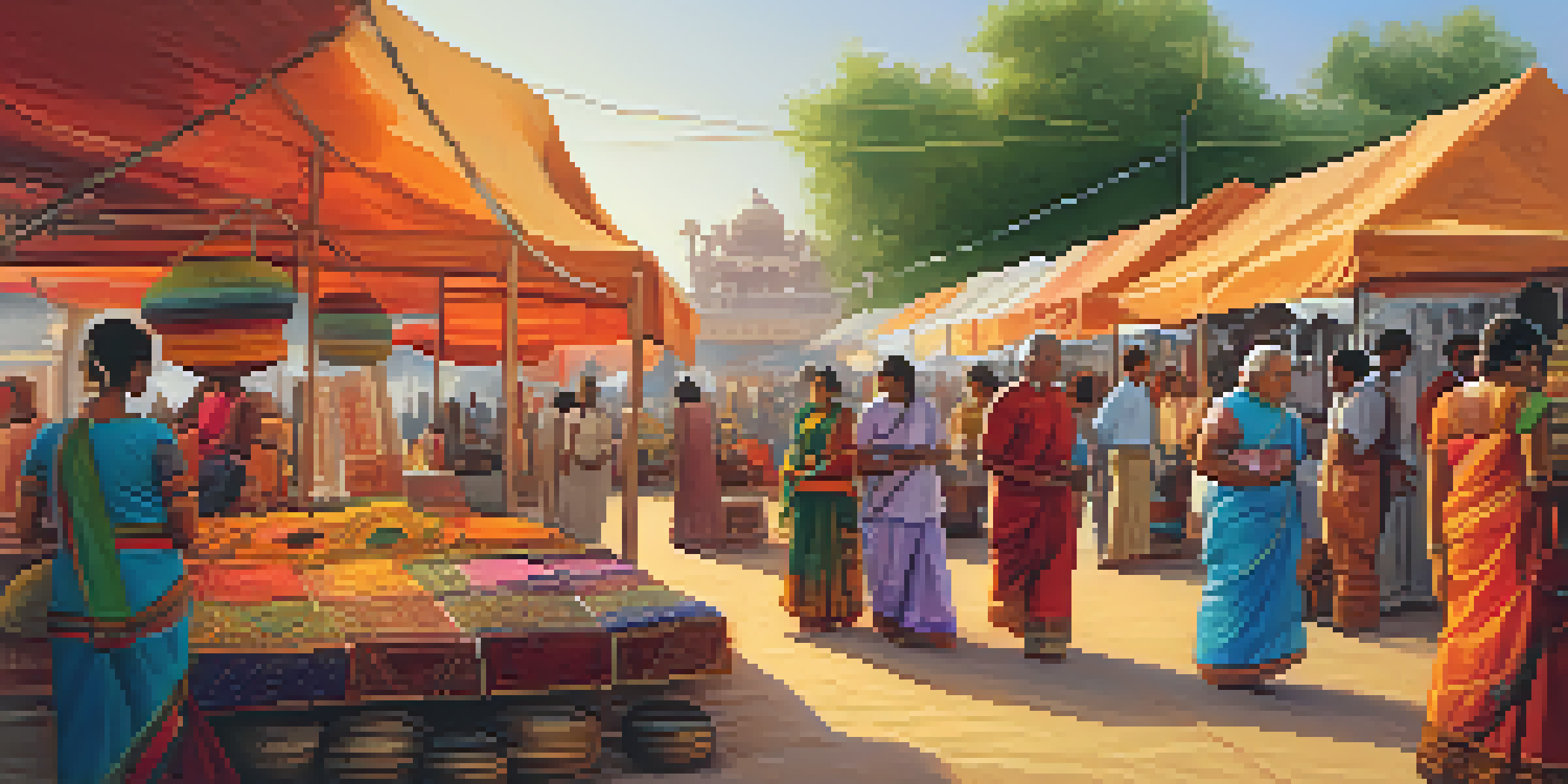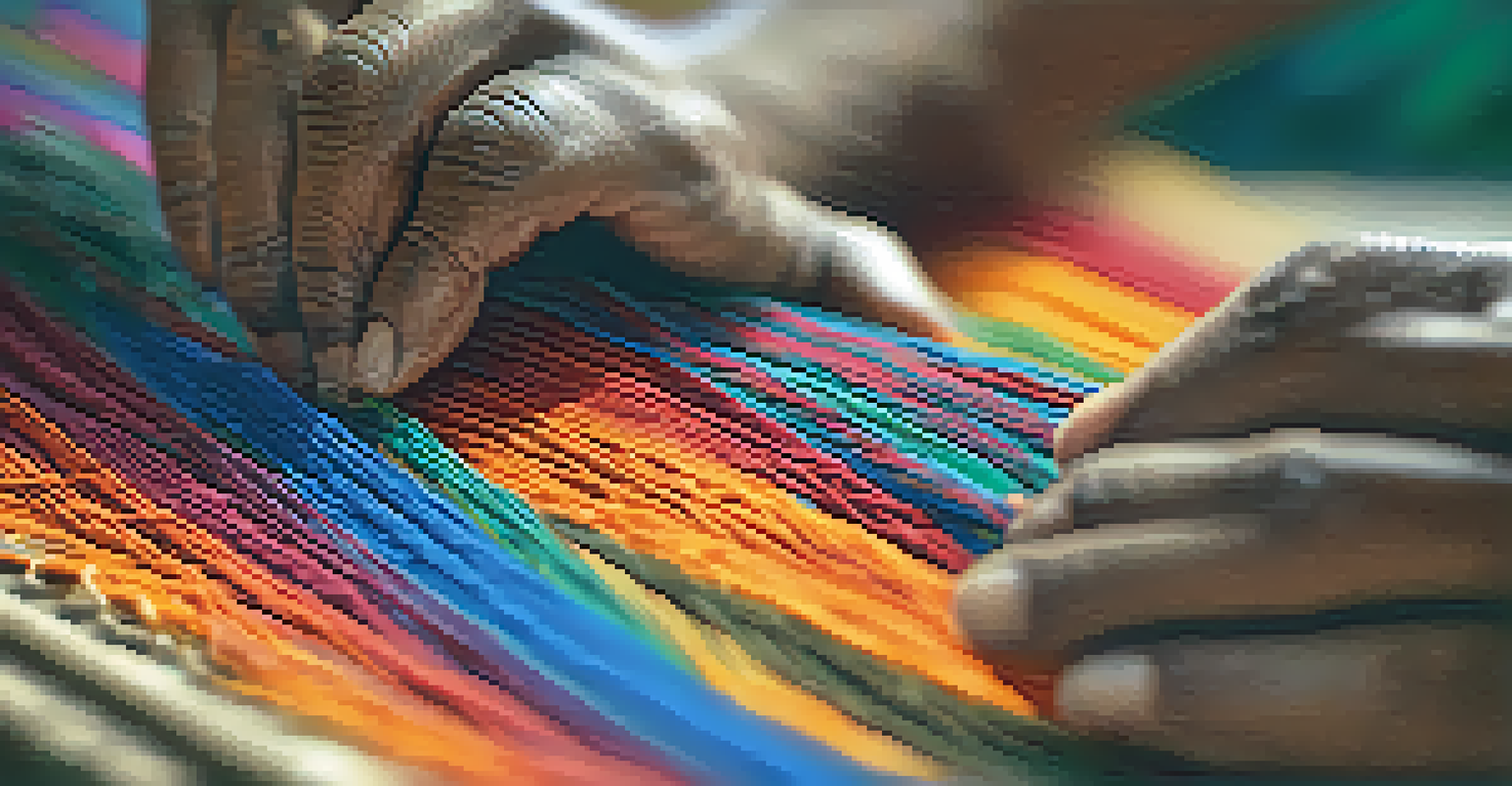The Evolution of Indian Art and Craft Fairs Over the Years

Origins of Indian Art and Craft Fairs in Ancient Traditions
Indian art and craft fairs have roots that date back to ancient times, where artisans showcased their skills during local festivals and gatherings. These events were not just about selling; they were vibrant celebrations of culture, where music, dance, and storytelling played significant roles.
Art is the most beautiful of all lies.
As communities evolved, these fairs became essential platforms for artisans to connect with patrons, fostering a sense of community and cultural exchange. The traditional barter system often facilitated these interactions, allowing for a rich tapestry of trades and relationships.
Through the centuries, these fairs have reflected the diverse artistic expressions of India's various regions, from intricate textiles of Rajasthan to exquisite pottery from Kerala. They served as a mirror to the society, capturing the essence of local traditions and craftsmanship.
The Impact of Colonialism on Art and Craft Fairs
The colonial period brought significant changes to the landscape of Indian art and craft fairs. With British influence, there was an introduction of new materials and techniques, which sometimes overshadowed traditional practices.

During this time, fairs began to incorporate Western aesthetics, leading to a fusion of styles that enriched Indian art. While this resulted in the birth of new art forms, it also posed challenges to indigenous artisans who struggled to maintain their unique identities.
Cultural Roots of Art Fairs
Indian art and craft fairs have deep historical roots, originating as vibrant celebrations of culture where artisans connected with their communities.
Despite these challenges, many artisans adapted, and some fairs began to serve as platforms for promoting indigenous crafts alongside colonial influences, paving the way for a rich, hybrid culture that continues to evolve today.
Post-Independence Revival of Indian Art and Craft Fairs
After India gained independence in 1947, there was a renewed interest in promoting indigenous art and crafts as symbols of national pride. This period saw the establishment of various fairs aimed at reviving traditional crafts that were at risk of being forgotten.
Every artist dips his brush in his own soul, and paints his own nature into his pictures.
Government initiatives, such as the establishment of the All India Handicrafts Board, played a crucial role in organizing these fairs, which began to attract not only local visitors but also international attention. This influx of interest helped artisans gain recognition and better livelihoods.
These fairs became vital spaces for artisans to showcase their work, share their stories, and connect with a broader audience, marking a significant shift in the perception of Indian art and crafts as valuable cultural heritage.
The Rise of Modern Art and Craft Fairs in Urban Settings
As cities grew and urban culture flourished, modern art and craft fairs began to emerge, blending traditional elements with contemporary art. These fairs often feature a diverse range of artists, from established names to emerging talents, creating a dynamic atmosphere.
The urban art scene has embraced digital technology, allowing artisans to showcase their work online and reach a global audience. This shift has transformed the way people engage with art, making it more accessible and interactive.
Challenges for Modern Artisans
Contemporary artisans face competition from mass-produced goods and the commercialization of fairs, which can obscure their cultural narratives.
Moreover, these modern fairs often include workshops, live demonstrations, and interactive sessions, fostering a deeper connection between artists and attendees. This participatory approach not only enhances the experience but also educates visitors about the craftsmanship involved.
Cultural Significance of Art and Craft Fairs Today
Today, art and craft fairs serve as cultural hotspots that celebrate the diversity of Indian art. They are platforms for storytelling, where artisans share their heritage and techniques, ensuring that traditions are passed down through generations.
These fairs also play a crucial role in promoting sustainability and ethical practices. Many artisans focus on eco-friendly materials and fair trade practices, aligning with the global movement towards responsible consumption.
Moreover, art and craft fairs have become community gatherings, fostering relationships among artists, consumers, and local businesses. This sense of community helps to strengthen local economies and encourages the preservation of traditional crafts.
Challenges Faced by Artisans in Contemporary Fairs
Despite their growth, artisans face several challenges in the contemporary fair scene, including competition from mass-produced items. Many consumers may opt for cheaper, factory-made products, undermining the value of handmade crafts.
Additionally, the commercialization of art fairs can sometimes overshadow the artisans' narratives, reducing their work to mere products rather than stories of culture and heritage. This shift can lead to a disconnect between artists and their audiences.
Future Trends in Art Fairs
The future of Indian art and craft fairs looks bright with increased digital integration, a focus on sustainability, and collaborations across disciplines.
To combat these challenges, many fairs are now emphasizing authenticity and the unique stories behind each piece, encouraging consumers to appreciate the craftsmanship and cultural significance of handmade art.
The Future of Indian Art and Craft Fairs: Trends to Watch
Looking ahead, the future of Indian art and craft fairs seems promising, with trends leaning towards increased digital integration. Virtual fairs and online marketplaces are becoming more popular, allowing artisans to reach wider audiences without geographical constraints.
Sustainability will likely continue to play a significant role, with consumers increasingly prioritizing eco-friendly products. Artisans who embrace sustainable practices will find themselves resonating more with conscious consumers.

Lastly, collaborations between artists across disciplines are expected to flourish, leading to innovative art forms that blend traditional craftsmanship with contemporary styles. This creative exchange will keep Indian art vibrant and relevant in an ever-evolving world.